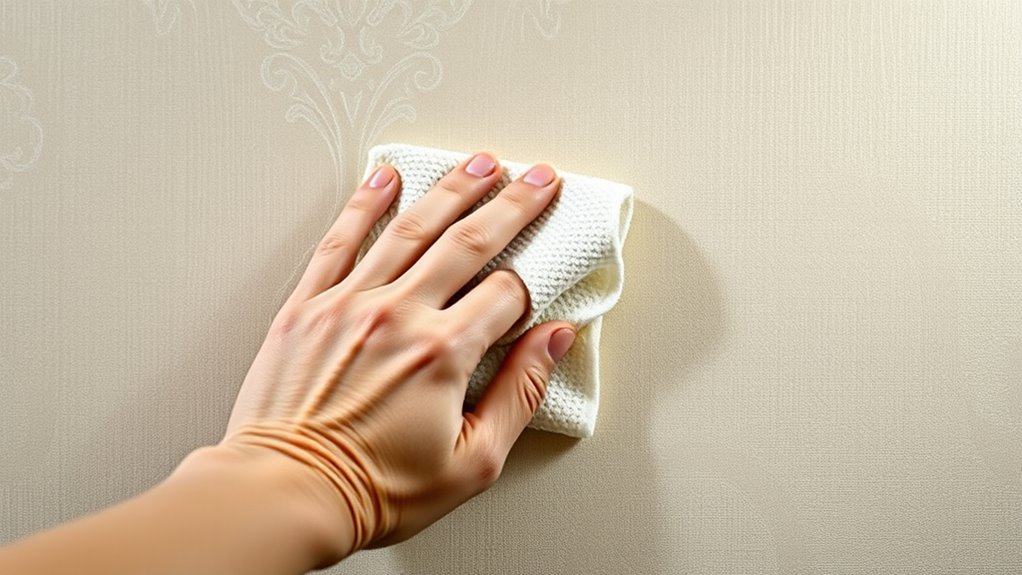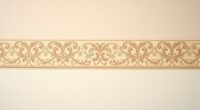To clean wallpaper, start by identifying its material. For vinyl, gently dust or wipe with a damp cloth using mild soap if needed. For fabric, prefer dry dusting and spot cleaning, avoiding moisture. Textured wallpapers should be vacuumed or brushed softly, while washable types respond well to mild detergents. Non-washable wallpapers require gentle dusting without water to prevent damage. Staying gentle and cautious helps maintain your wallpaper’s look—explore further to find out specifics for each material.
Key Takeaways
- Identify your wallpaper material (vinyl, fabric, textured, washable, non-washable) to choose appropriate cleaning methods.
- Use soft, damp cloths or gentle vacuuming to remove dust without damaging delicate surfaces.
- Test cleaning solutions on hidden areas before full application to prevent staining or peeling.
- For washable wallpapers, mild detergents or natural remedies like vinegar or baking soda are effective.
- Avoid excessive moisture and abrasive tools, especially on non-washable or delicate wallpapers, to prevent damage.
Cleaning Vinyl Wallpaper

Cleaning vinyl wallpaper is a straightforward process that helps keep your walls looking fresh and spotless. Start by gently removing dust and dirt with a soft cloth or vacuum with a brush attachment. If you notice stains, use a mild soap solution or a mixture of water and a few drops of dish detergent. For tougher spots, apply a small amount of stain removal solution, but avoid harsh chemicals that could damage the vinyl surface. When cleaning around wallpaper adhesives, be careful not to dislodge the edges or weaken the adhesive bond. Always test any cleaning solution on a small, hidden area first. Regular maintenance will preserve the appearance of your vinyl wallpaper and prevent dirt buildup, ensuring it stays vibrant and clean.
Caring for Fabric Wallpaper

Since fabric wallpaper is more delicate than other types, it requires gentle care to maintain its appearance. To guarantee proper fabric care and upholstery maintenance, avoid harsh cleaning methods. Use a soft, dry cloth to gently dust the surface regularly. For stains, lightly dab with a damp cloth and mild soap, avoiding excessive moisture. Always test cleaning solutions in a hidden area first. Be cautious with steam cleaners, as they might damage the fabric. Keep humidity levels low to prevent mold. Additionally, regular maintenance can help extend the lifespan of fabric wallpaper and prevent the need for costly replacements. Incorporating proper cleaning techniques can also minimize the risk of damage. It’s also beneficial to understand the material composition of your wallpaper to choose suitable cleaning methods. Here’s a quick guide:
| Cleaning Method | Tips |
|---|---|
| Dusting | Use a soft, dry cloth |
| Spot Cleaning | Light damp cloth with mild soap |
| Avoid Steam Cleaning | Could damage delicate fabric |
| Regular Inspection | Check for stains or damage |
Maintaining Textured Wallpaper
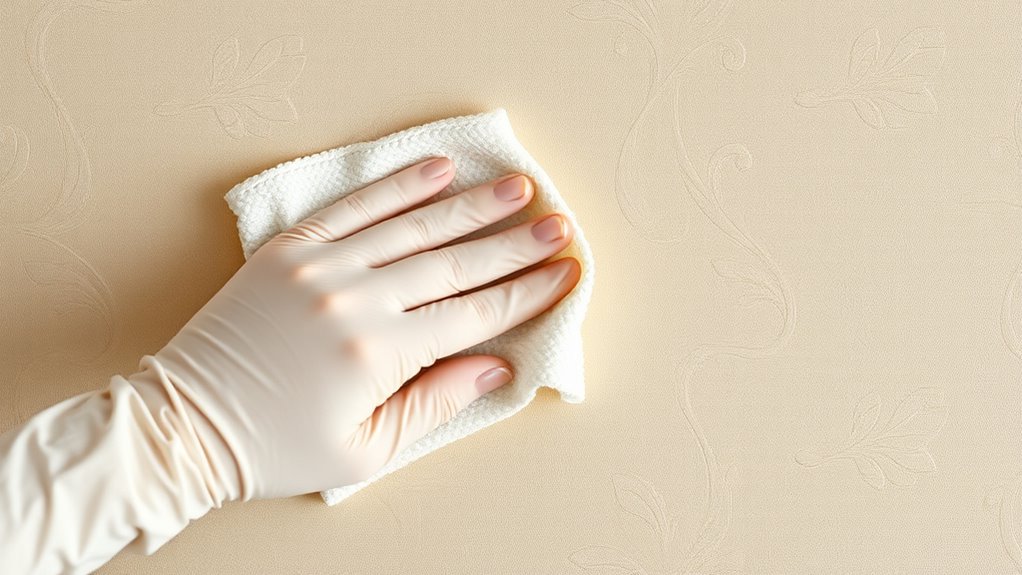
Maintaining textured wallpaper requires careful attention to preserve its intricate surface. Textured wallcoverings add depth and dimension, but their patterns can easily be damaged if you’re too vigorous during cleaning. Use a soft, dry cloth or a gentle vacuum brush attachment to remove dust and dirt regularly. When cleaning, avoid excessive moisture, which can cause the texture to lift or warp. Spot clean with a damp sponge and mild soap, gently dabbing to prevent pattern disruption. Never scrub or use abrasive tools that could flatten or damage the surface. Consistent, gentle maintenance helps keep the pattern sharp and vibrant over time, ensuring your textured wallcoverings remain an attractive feature in your space. Proper care is key to pattern preservation and long-lasting beauty. Additionally, understanding remote work benefits can inspire you to create a comfortable and productive environment at home that preserves your decor. Being aware of return policies can also help if you need to replace or exchange damaged wallpaper or related supplies. To further protect the texture, it’s helpful to avoid harsh chemicals, which can deteriorate delicate surfaces over time. Incorporating regular inspections can help identify potential issues early before they cause lasting damage.
Tips for Washable Wallpaper
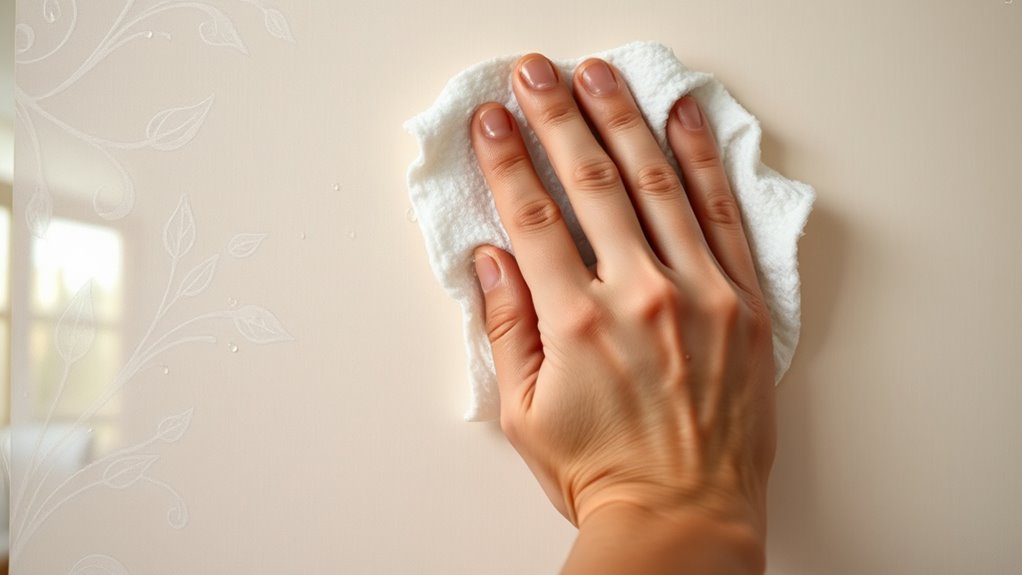
When cleaning washable wallpaper, use gentle techniques to safeguard damage. Always opt for mild detergents and apply them carefully to prevent staining or peeling. Remember to spot test in a small, hidden area first to ensure your method is safe. Using a soft cloth or sponge can help minimize the risk of tearing or scrubbing off the design. Additionally, ensuring proper wallpaper maintenance can extend its lifespan and keep it looking fresh. Incorporating AI-powered cleaning tips can also assist in selecting the most suitable cleaning methods for different materials. Being aware of security in payment processing can help protect your personal information during online transactions.
Gentle Cleaning Techniques
To keep washable wallpaper looking fresh, it’s essential to use gentle cleaning techniques that won’t damage the surface. Start with eco-friendly solutions like a mixture of mild soap and water, avoiding harsh chemicals. Use a soft sponge or microfiber cloth to gently wipe the wallpaper, applying light pressure. For stain removal, opt for natural remedies such as a baking soda paste or diluted vinegar, which are effective and safe. Always test a small, inconspicuous area first to prevent discoloration. Avoid scrubbing vigorously, as this can cause peeling or damage. Regular, gentle cleaning helps maintain your wallpaper’s appearance while protecting its integrity. Additionally, understanding the material-specific requirements ensures you choose the most suitable cleaning method for your wallpaper type. Being aware of wallpaper material characteristics can prevent potential damage during cleaning. Incorporating proper maintenance practices can extend the lifespan of your wallpaper and keep it looking its best. Staying informed about legislative changes related to cleaning and maintenance can help you adapt your approach as needed.
Use Mild Detergents
After using gentle cleaning methods to remove surface dirt and stains, choosing the right detergents guarantees your wallpaper stays in top condition. Use mild detergents specifically formulated for wallpaper or lightly diluted dish soap. Eco-friendly options are a great choice, as they’re gentle on your walls and better for the environment. When tackling stains, a mild detergent can help with stain removal without damaging the wallpaper’s finish. Remember, harsh chemicals can cause discoloration or peeling. Always read labels to ensure compatibility and avoid damage. Incorporating safe cleaning products during cleaning routines can promote relaxation and reduce stress.
Spot Test First
Wondering how to prevent accidental damage while cleaning your washable wallpaper? Always start with a spot test. Apply a small amount of your cleaning solution to a hidden area first. This helps you check for potential wallpaper damage and ensures your chosen method won’t cause discoloration or peeling. Keep in mind that frequent cleaning can increase the risk of wear, so testing helps determine the right cleaning frequency without harming the wallpaper. If the spot test goes well, proceed gently, avoiding harsh scrubbing. Spot testing is a simple step that saves you time and money by preventing costly repairs or replacements. Remember, each wallpaper material reacts differently, so taking this precaution is essential for maintaining its appearance over time. Additionally, understanding the material composition of your wallpaper can guide you toward the most suitable cleaning methods and products. Being aware of wallpaper durability can also help you choose appropriate cleaning techniques and avoid damage during maintenance. To make informed decisions, familiarize yourself with wallpaper care guidelines that are specific to your wallpaper type. Recognizing the importance of angel number wisdom can help you interpret subtle signs and messages during your maintenance process, promoting a more mindful approach to home care.
Handling Non-Washable Wallpaper
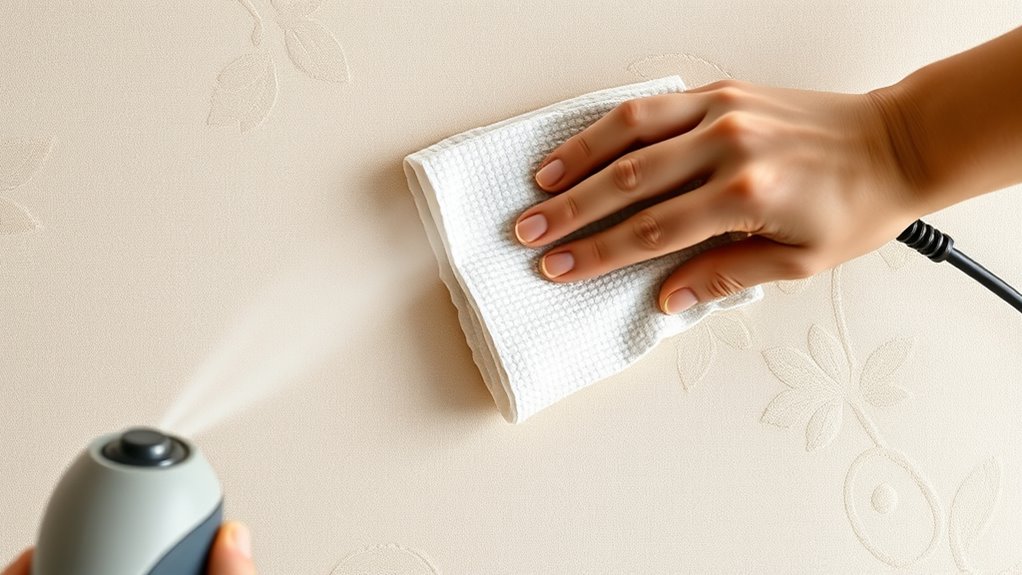
When dealing with non-washable wallpaper, you need to be extra careful to avoid damage. Unlike washable types, scrubbing or wet cleaning can cause peeling or tearing. To maintain its integrity, focus on gentle dusting or vacuuming with a soft brush. Before any cleaning, verify proper wall preparation by removing dust and loose particles. Be cautious with wallpaper adhesives; avoid applying water directly, as moisture can weaken the adhesive bonds. Instead, use a dry microfiber cloth or a soft brush to remove surface dirt. Remember, non-washable wallpaper responds poorly to moisture, so always opt for dry cleaning methods. Additionally, understanding paint sprayer maintenance and proper cleaning techniques can help prevent accidental damage during home upkeep.
General Cleaning Tips for All Wallpaper Types
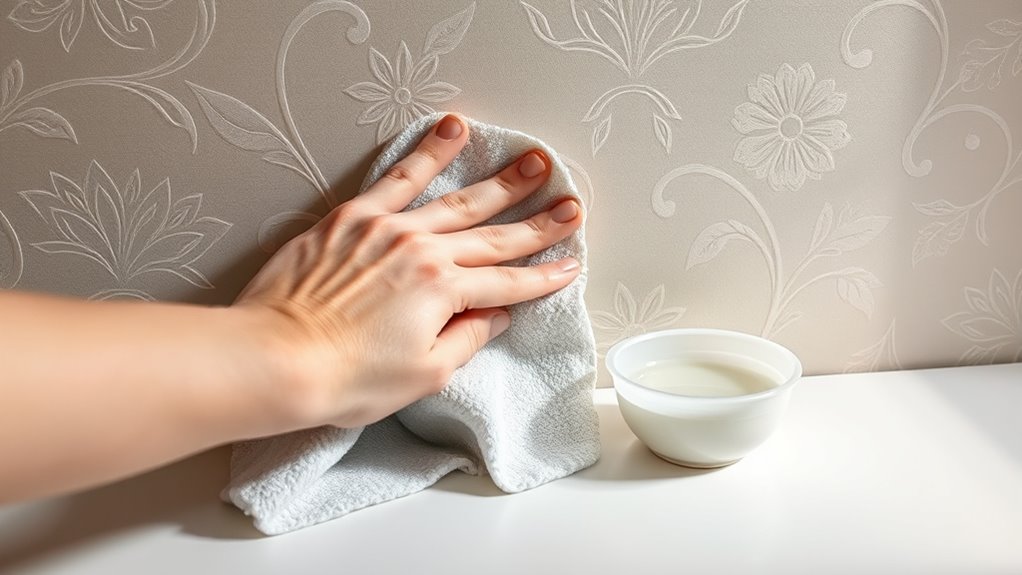
When cleaning wallpaper, use gentle techniques to avoid damage. Always test a small, hidden area first to make certain your method won’t harm the surface. Be careful not to use too much moisture, as excess water can cause peeling or staining.
Gentle Cleaning Techniques
Cleaning wallpaper gently is essential to prevent damage and keep it looking fresh. Use soft materials and light touch to avoid tearing or peeling. When cleaning, opt for a damp cloth or sponge, and never soak the wallpaper. Steam cleaning can be effective for stubborn dirt but should be used cautiously, ensuring the steam isn’t too hot or prolonged. Avoid abrasive scrubbing, which can scratch or lift the wallpaper’s surface. Instead, gently wipe in a circular motion. Remember, patience is key—treat each section carefully. Always test a small, inconspicuous area first. To help you succeed, keep these tips in mind:
- Use a soft, microfiber cloth
- Avoid harsh chemicals
- Keep cleaning tools damp, not soaked
- Use gentle, circular motions
- Limit steam cleaning to necessary areas
Test Before Cleaning
Before you start cleaning your wallpaper, it’s essential to test a small, hidden area first. This ensures proper surface preparation and helps prevent damage during stain removal. Choose a discreet spot, like behind furniture or a corner, and gently apply your cleaning method. Watch for any discoloration, peeling, or texture changes. If the test area remains intact, proceed carefully. Here’s a quick reference:
| Testing Step | Purpose |
|---|---|
| Apply minimal cleaner | Check for surface sensitivity and color fastness |
| Observe for 5 minutes | Detect any immediate reactions or damage |
| Test stain removal method | Ensure it won’t harm your wallpaper |
| Confirm stability | Proceed confidently with full cleaning |
This essential step saves you time and preserves your wallpaper’s beauty.
Avoid Excess Moisture
After testing your wallpaper, it’s important to be mindful of moisture levels during cleaning. Excess moisture can damage the adhesive or cause the wallpaper to peel. To maintain moisture control, avoid over-wetting the surface and use a damp cloth rather than a soaking one. Limiting cleaning frequency helps prevent unnecessary moisture exposure, which can weaken the wallpaper’s integrity over time. Focus on spot cleaning rather than full washes unless necessary. Always dry the surface thoroughly after cleaning to prevent mold growth. Remember these tips:
- Use minimal water during cleaning
- Avoid saturating the wallpaper
- Clean spills immediately to prevent moisture build-up
- Increase cleaning frequency only as needed
- Ventilate the room well during and after cleaning
Controlling moisture is essential for preserving your wallpaper’s appearance and longevity.
Frequently Asked Questions
Can Wallpaper Be Cleaned With Household Disinfectants Safely?
Yes, you can use household disinfectants to clean wallpaper, but you should be cautious. Test a small, hidden area first to see how your wallpaper texture reacts. Use gentle cleaning solutions and avoid harsh chemicals that may damage or peel the wallpaper. For best results, opt for a mild disinfectant, like diluted vinegar or a gentle soap solution, and gently wipe the surface without scrubbing.
How Often Should Wallpaper Be Cleaned to Prevent Damage?
You should clean your wallpaper every 3 to 6 months to prevent damage. For example, a family noticed dirt buildup and stains after a year, making stain removal difficult. Regular cleaning helps remove dirt buildup and keeps your wallpaper looking fresh. Use gentle methods to avoid damage, and spot clean stains promptly. Consistent maintenance preserves your wallpaper’s appearance and prevents more extensive cleaning later on.
Are There Eco-Friendly Cleaning Options for Wallpaper Maintenance?
Yes, there are eco-friendly options for cleaning your wallpaper. You can use natural cleaning solutions like a mixture of water and white vinegar or gentle castile soap to remove dirt and stains. These natural cleaning methods are safe for your environment and your home. Always test a small area first to verify your wallpaper responds well, and avoid harsh chemicals to keep your wallpaper and indoor air quality healthy.
What Are Signs That Wallpaper Needs Replacement Rather Than Cleaning?
If your wallpaper shows signs of discoloration or peeling, it’s time to replace it rather than clean. Discoloration indicates fading or staining that cleaning won’t fix, while peeling suggests the adhesive no longer holds properly. You might also notice cracks or bubbles forming. These issues compromise the appearance and durability, making replacement the best option to restore your space’s look and prevent further damage.
Can Cleaning Damage the Wallpaper’s Adhesive or Surface?
While cleaning wallpaper, you might worry about damaging the surface or adhesive deterioration, but gentle methods prevent this. Using a soft cloth and mild solutions minimizes the risk of surface peeling or weakening the adhesive. Avoid harsh scrubbing or excessive moisture, which can compromise the wallpaper’s integrity. Proper cleaning not only preserves your wallpaper’s appearance but also extends its lifespan without causing damage.
Conclusion
No matter what type of wallpaper you have, keeping it clean is like giving it a fresh coat of life. By following the right cleaning methods, you’ll preserve its beauty and extend its lifespan. Think of your wallpaper as a silent guardian of your home’s style—treat it with care, and it’ll continue to shine like a beacon of elegance. With a little effort, your walls will stay stunning and inviting for years to come.
